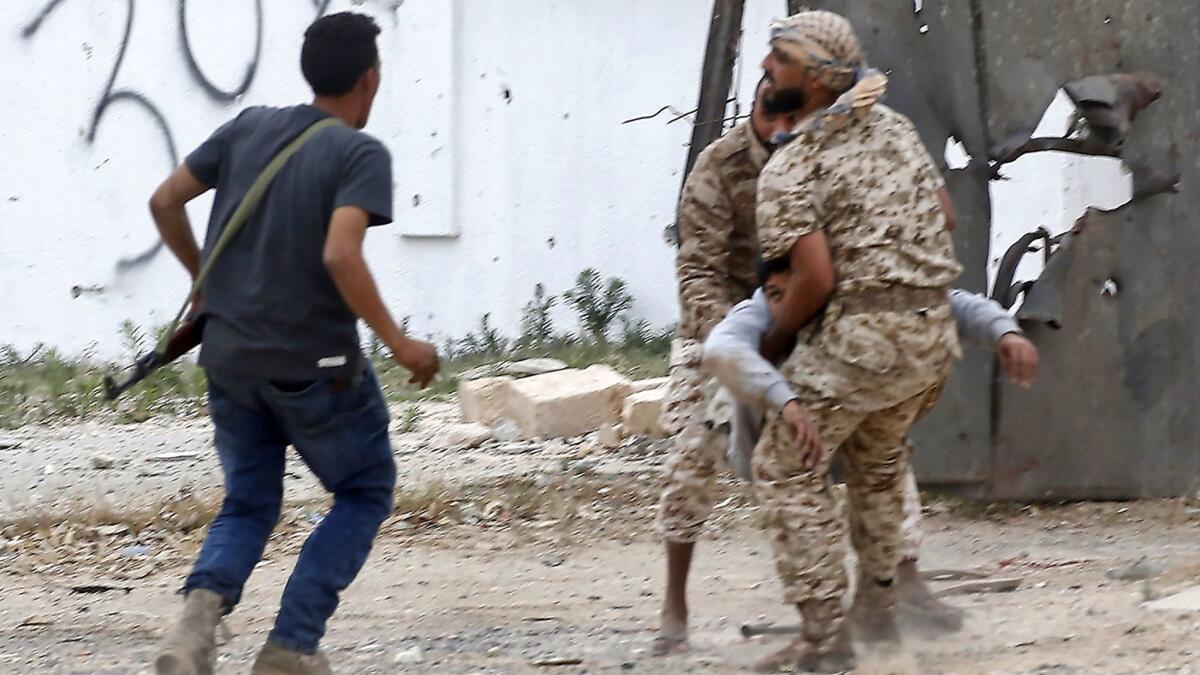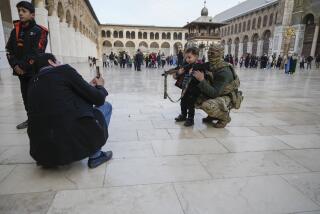Libya post-Kadafi: Lurching from one crisis to another

- Share via
Reporting from Tripoli, Libya — On paper, Libya should be booming. It’s one of the world’s top 10 countries in oil reserves. It has more than a thousand miles of coastline on the Mediterranean. And it serves as a vital conduit linking Africa, Europe and the Middle East.
But since the Arab Spring revolutions in 2011, when rebel forces, augmented by NATO airstrikes and enforcement of a no-fly zone, toppled the country’s longtime ruler, Col. Moammar Kadafi, the northern African nation has lurched from one crisis to another.
Rather than Libya having money to burn, rival Libyan fighters have done little more than use it to burn each other and the country along with them.
“I always considered my compatriots in Lebanon as stupid enough to commit suicide with somebody else’s money. The Libyans are even worse: They are committing suicide with their [own] money,” said Ghassan Salame, the United Nations’ envoy to Libya and a Lebanese (and therefore no stranger to civil wars), in a bitter talk he delivered at the New York-based International Peace Institute on Wednesday.
What’s happening now?
Last month, Khalifa Haftar, who served under Kadafi as a general but eventually sought to overthrow him, launched an all-out offensive to wrest Tripoli, the capital, from the U.N.-recognized Government of National Accord. But his self-styled Libyan National Army, despite having made significant gains in eastern and southern Libya, has been stymied in attempts to enter the capital, home to more than 2.5 million people, by armed factions loyal to the GNA.
As the fighting stretches into its eighth week, it threatens to plunge the country into yet another all-out civil war, its third since Kadafi was ousted and later killed in October 2011. Meanwhile, more than 75,000 Tripoli residents have fled their homes, and hundreds have been killed. The capital’s southern outskirts have become ravaged front-line areas, and on Friday, the GNA accused Haftar’s forces of launching a rocket attack on a luxury hotel in the city center used for government meetings.
How did we get to this point?
The groups that rose in 2011 had little in common other than hatred of Kadafi. Once he was shot to death after being captured in a drainage pipe in the coastal city of Surt, militias that had been organized along tribal or ideological lines turned on each other. With no true national actor among them (politics is a local affair in Libya, a result of Kadafi playing off different sides so a clear challenger would never emerge), the country fractured into a vicious free-for-all. Criminal and Islamist groups, including Al Qaeda and Islamic State, operated in full view of a government unable (and often unwilling) to do anything about them.
In 2014, Haftar emerged as a figure who could dislodge the Islamists from eastern Libya and the city of Benghazi, where militants had attacked a U.S. diplomatic outpost two years earlier, killing Ambassador Christopher Stevens and three of his staffers.
It took years to do so, but, crucially, Haftar also managed to seize petroleum infrastructure in the east and keep the oil flowing. In the meantime, a rival government arose in the east and appointed him as the head of the Libyan National Army, which includes a core of Kadafi-era officers and soldiers as well as a number of other armed groups, including Salafists.
To stanch further bloodshed, the sides agreed to create an interim government, the GNA, led by Prime Minister Fayez Sarraj, an engineer by profession.
But the GNA has proved weak, and had until recently made little progress toward holding elections and strengthening state institutions. It is also seen as beholden to four armed factions that have entrenched themselves in the inner workings of the state and its finances.
With the east and southern parts of the country already in his hands, Haftar decided that, rather than work with the GNA, he would take the capital and claim power for himself.
So who is fighting him?
The four major factions controlling the capital, known as the Tripoli Protection Force, have mounted the main defense. They are what is known as the Tripoli Revolutionaries Brigade, the Nawasi Battalion, the Abu Salim Central Security Forces and the Bab Tajoura Brigade. (The names reflect the tribal and location-conscious nature of their formation.)
They’ve been joined by groups from western Libyan cities such as Zintan and Misurata; the latter are known to be especially fierce fighters. Also with them are Islamists seeking to pay back their losses at Haftar’s hands.
It’s hard to say who the good guys are. The cast of characters on both sides includes fighters and commanders sanctioned by the U.N. or indicted by the International Criminal Court.
Does Haftar have international support?
The GNA has U.N. recognition, and, at least outwardly, countries have given it their support. But in reality, Haftar has received funds, weapons and materiel, as well as logistical support, from the United Arab Emirates, France, Saudi Arabia, Egypt, Russia and others.
The GNA has received assistance including funds from Qatar and weapons from Turkey. Last week, there were reports of a delivery of mine-resistant vehicles to the GNA from Turkey.
Libya, said Salame on Wednesday, is “a textbook example of foreign interference today in local conflicts.” Between “six and 10 countries are permanently interfering in Libya’s problem,” he said.
What’s the reaction of the U.S.?
In a word, confused.
The recent flareup pushed the U.S. to remove a contingent of its troops from Libya, and U.S. Secretary of State Michael R. Pompeo issued a statement in April saying a political solution was the only way to unify Libya. “There is no military solution,” he said.
“We have made clear that we oppose the military offensive by Khalifa Haftar’s forces and urge the immediate halt to these military operations against the Libyan capital,” he said.
But that sentiment was later torpedoed by President Trump, who in a phone call to Haftar lauded the strongman’s “significant role in fighting terrorism and securing Libya’s oil resources.”
It was followed by a statement from acting U.S. Defense Secretary Patrick Shanahan, who said that Washington needed Haftar’s “support in building democratic stability there in the region.”
Haftar is also naturalized U.S. citizen, not to mention a onetime CIA asset. That pushed a number of lawmakers last week to send a letter to the Justice Department asking to investigate Haftar for alleged war crimes.
For Tripoli residents, snatches of normality in a life disrupted »
More to Read
Sign up for Essential California
The most important California stories and recommendations in your inbox every morning.
You may occasionally receive promotional content from the Los Angeles Times.











